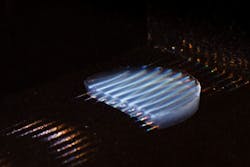Transparent Aerogel Traps Solar Heat
A newly developed aerogel made mostly of air surrounding a silica structure is so transparent you can barely see it. But it could hold the key to unlocking new applications for solar heating. It traps much higher temperatures of solar heat than conventional solar collectors do. In fact, it can trap enough to be heat homes or carry out industrial processes, more than 392°F (200°C).
The aerogel, which was developed at MIT, lets sunlight pass through easily but blocks solar heat from escaping. The key to key to efficiently collecting of solar heat is the ability to keep something hot internally while remaining cold on the outside. One way of doing that is by sandwiching a vacuum between a layer of glass and layer of dark, heat-absorbing material. This is method used in many concentrating solar collectors but is relatively expensive to install and maintain. There has been great interest in finding less-expensive, passive ways to collect solar heat at higher temperatures and use it for heating houses and building, cooking food, and many industrial processes.
The new aerogel insulating material is highly transparent, transmitting 95% of light. In this photo, parallel laser beams make the material visible.
Aerogels, a kind of foam-like material made of silica particles, have been developed for years as highly efficient and lightweight insulating materials, but they have generally had limited transparency to visible light, with around a 70% transmission level. Developing aerogels transparent enough to work for solar heat collection was a four-year project involving several MIT researchers. But the result is an aerogel that lets through over 95% of incoming sunlight while maintaining its highly insulating properties.
The key to making it work was in using precise ratios of the different materials used to create the aerogel, which are made by mixing a catalyst with grains of a silica-containing compound in a liquid solution. This forms a gel which is dried out to remove all the liquid, leaving a matrix made up of mostly air but retaining the original mixture’s strength. Coming up with a mix that dries out much faster than those used to make conventional aerogels let the team create a gel with smaller pore spaces between grains. Consequently, the light was scattered much less.
Such high temperatures have previously only been practical by using concentrating setups with mirrors to focus sunlight onto a central line or point. This new aerogel requires no concentration, however, making it simpler and less costly to concentrate solar heat.
In tests on a rooftop on the MIT campus, a passive device consisting of a heat-absorbing dark material covered with a layer of the new aerogel reached and maintained a temperature of 220°C in the middle of a Cambridge winter when the outside air was below 0°C.
The aerogel could beef up simple flat rooftop collectors. These are often used for domestic hot water, generating temperatures of around 80°C. But the higher temperatures enabled by the aerogel could make simple systems usable for home heating and air conditioning. Large-scale versions could provide heat for a wide variety of applications in chemical, food production, and manufacturing.
For most purposes, the passive heat collection system would be connected to pipes containing a liquid that could circulate to transfer the heat to wherever it’s needed. Alternatively, for some uses the system could be connected to heat pipes, devices that transfer heat over a distance without requiring pumps or any moving parts.
Because the principle is essentially the same, an aerogel-based solar heat collector could directly replace vacuum-based collectors used in some applications, providing a lower-cost option. The materials used to make the aerogel are all abundant and inexpensive; the only costly part of the process is the drying, which requires a device called a critical point dryer to carry out a precise drying process that extracts solvents from the gel while preserving its nanoscale structure.
Because that is a batch process rather than a continuous one that could be used in roll-to-roll manufacturing, it could be difficult to scale up to industrial production levels. But even now, a preliminary economic analysis shows that the system can be economically viable for some uses, especially in comparison to vacuum-based systems.



